Report on Engineering Sustainability: Energy Production and Challenges
VerifiedAdded on 2020/02/24
|11
|2531
|54
Report
AI Summary
This report comprehensively examines engineering sustainability, focusing on energy production across urban, commercial, and global contexts. It delves into the infrastructures supporting transportation and consumer electricity, while also exploring historical energy production methods and their evolution. The report identifies challenges in maintaining energy supply, including the need for renewable resources and government involvement. It underscores the importance of addressing global warming, resource depletion, and the shift towards sustainable infrastructure. The report provides an overview of the current energy landscape, challenges, and potential solutions for a sustainable future. It emphasizes the need to balance economic growth with environmental protection and ensuring energy availability for future generations. The report concludes by summarizing the key findings and recommendations for achieving engineering sustainability in the energy sector.
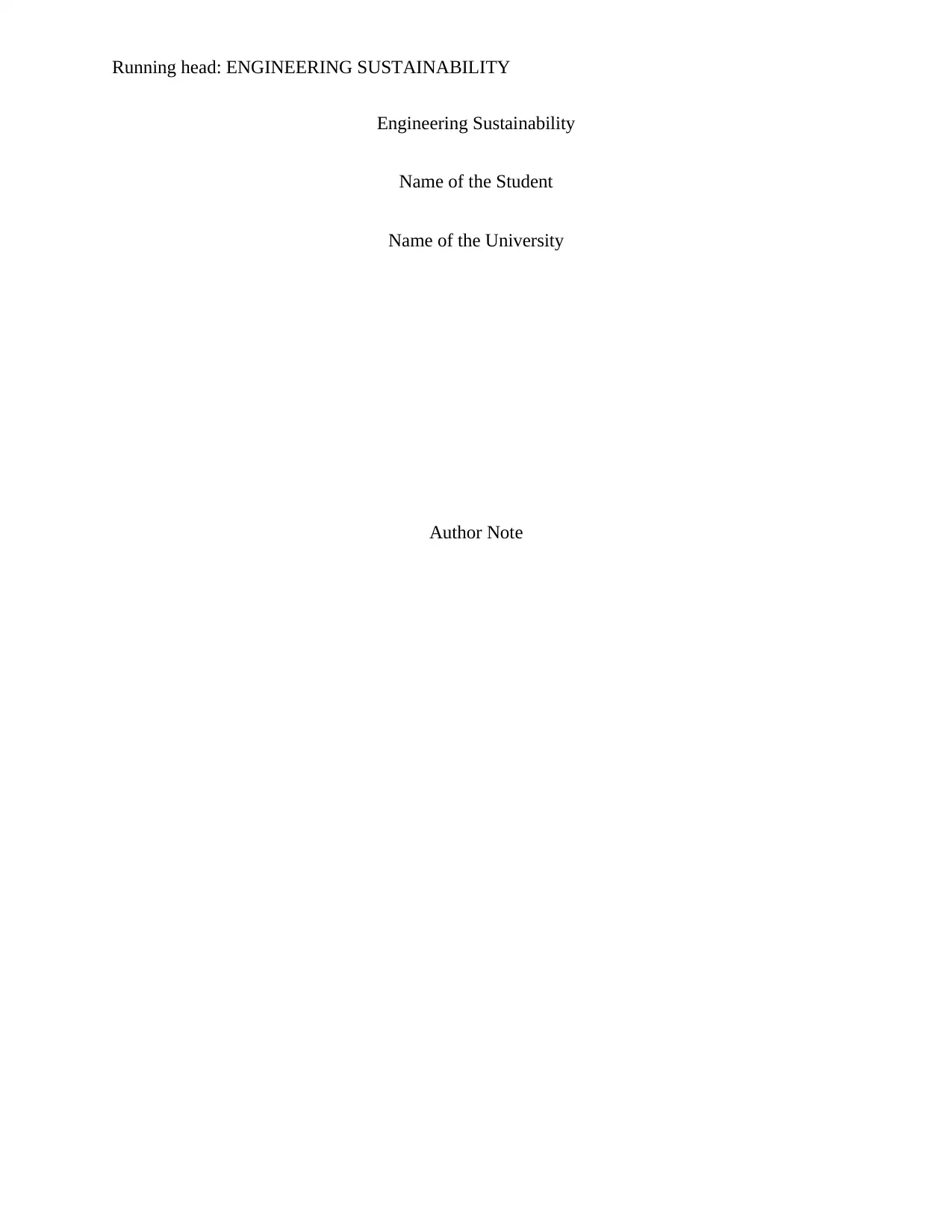
Running head: ENGINEERING SUSTAINABILITY
Engineering Sustainability
Name of the Student
Name of the University
Author Note
Engineering Sustainability
Name of the Student
Name of the University
Author Note
Paraphrase This Document
Need a fresh take? Get an instant paraphrase of this document with our AI Paraphraser
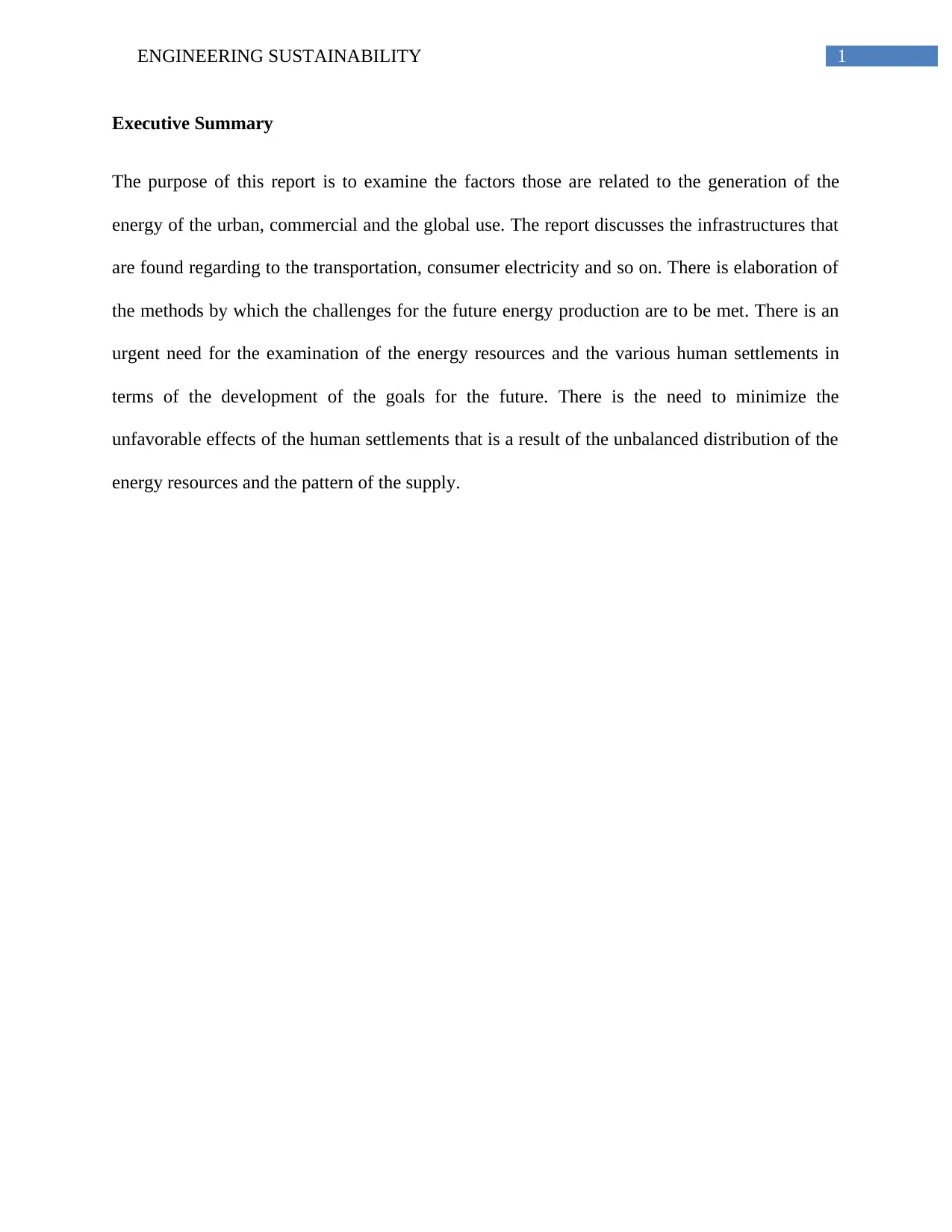
1ENGINEERING SUSTAINABILITY
Executive Summary
The purpose of this report is to examine the factors those are related to the generation of the
energy of the urban, commercial and the global use. The report discusses the infrastructures that
are found regarding to the transportation, consumer electricity and so on. There is elaboration of
the methods by which the challenges for the future energy production are to be met. There is an
urgent need for the examination of the energy resources and the various human settlements in
terms of the development of the goals for the future. There is the need to minimize the
unfavorable effects of the human settlements that is a result of the unbalanced distribution of the
energy resources and the pattern of the supply.
Executive Summary
The purpose of this report is to examine the factors those are related to the generation of the
energy of the urban, commercial and the global use. The report discusses the infrastructures that
are found regarding to the transportation, consumer electricity and so on. There is elaboration of
the methods by which the challenges for the future energy production are to be met. There is an
urgent need for the examination of the energy resources and the various human settlements in
terms of the development of the goals for the future. There is the need to minimize the
unfavorable effects of the human settlements that is a result of the unbalanced distribution of the
energy resources and the pattern of the supply.
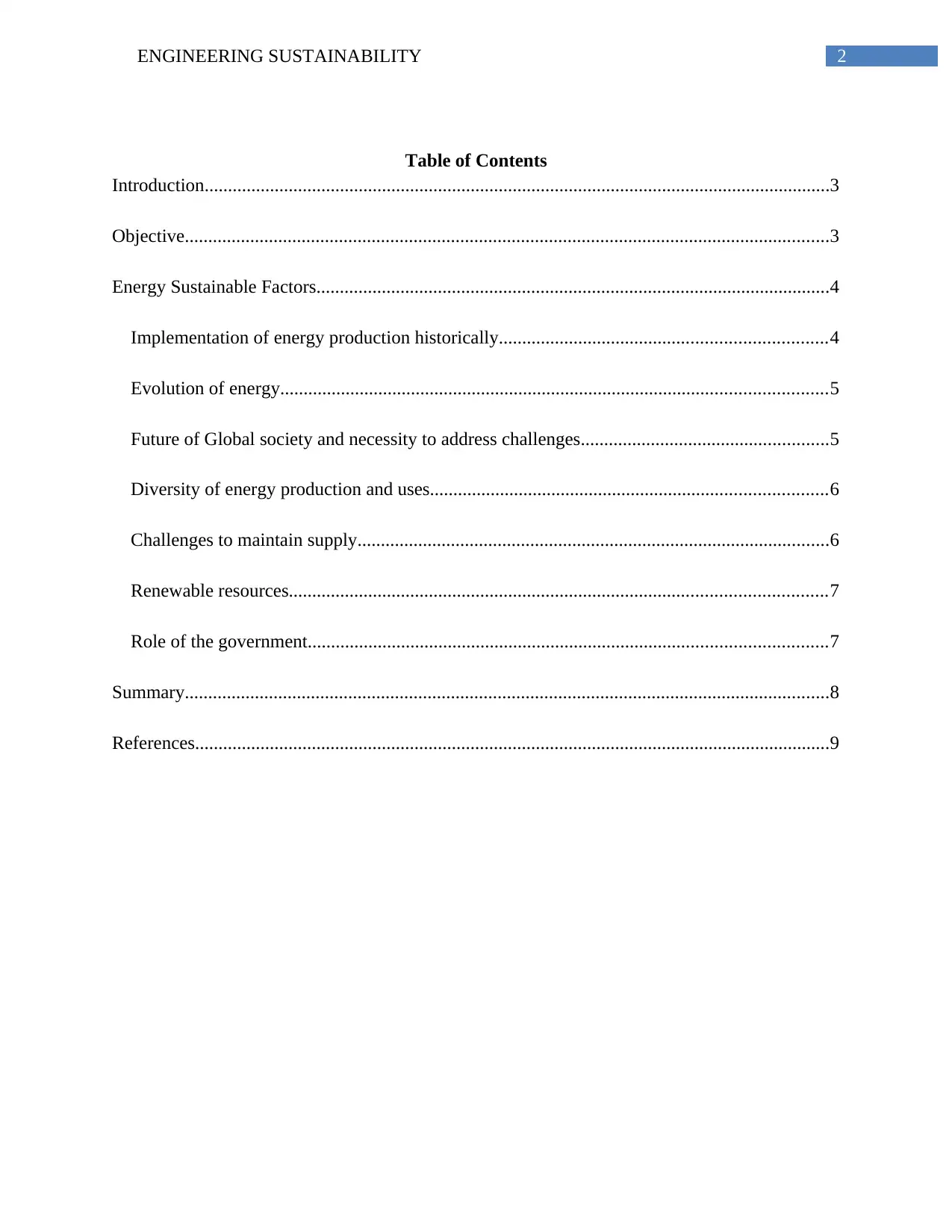
2ENGINEERING SUSTAINABILITY
Table of Contents
Introduction......................................................................................................................................3
Objective..........................................................................................................................................3
Energy Sustainable Factors..............................................................................................................4
Implementation of energy production historically......................................................................4
Evolution of energy.....................................................................................................................5
Future of Global society and necessity to address challenges.....................................................5
Diversity of energy production and uses.....................................................................................6
Challenges to maintain supply.....................................................................................................6
Renewable resources...................................................................................................................7
Role of the government...............................................................................................................7
Summary..........................................................................................................................................8
References........................................................................................................................................9
Table of Contents
Introduction......................................................................................................................................3
Objective..........................................................................................................................................3
Energy Sustainable Factors..............................................................................................................4
Implementation of energy production historically......................................................................4
Evolution of energy.....................................................................................................................5
Future of Global society and necessity to address challenges.....................................................5
Diversity of energy production and uses.....................................................................................6
Challenges to maintain supply.....................................................................................................6
Renewable resources...................................................................................................................7
Role of the government...............................................................................................................7
Summary..........................................................................................................................................8
References........................................................................................................................................9
⊘ This is a preview!⊘
Do you want full access?
Subscribe today to unlock all pages.

Trusted by 1+ million students worldwide
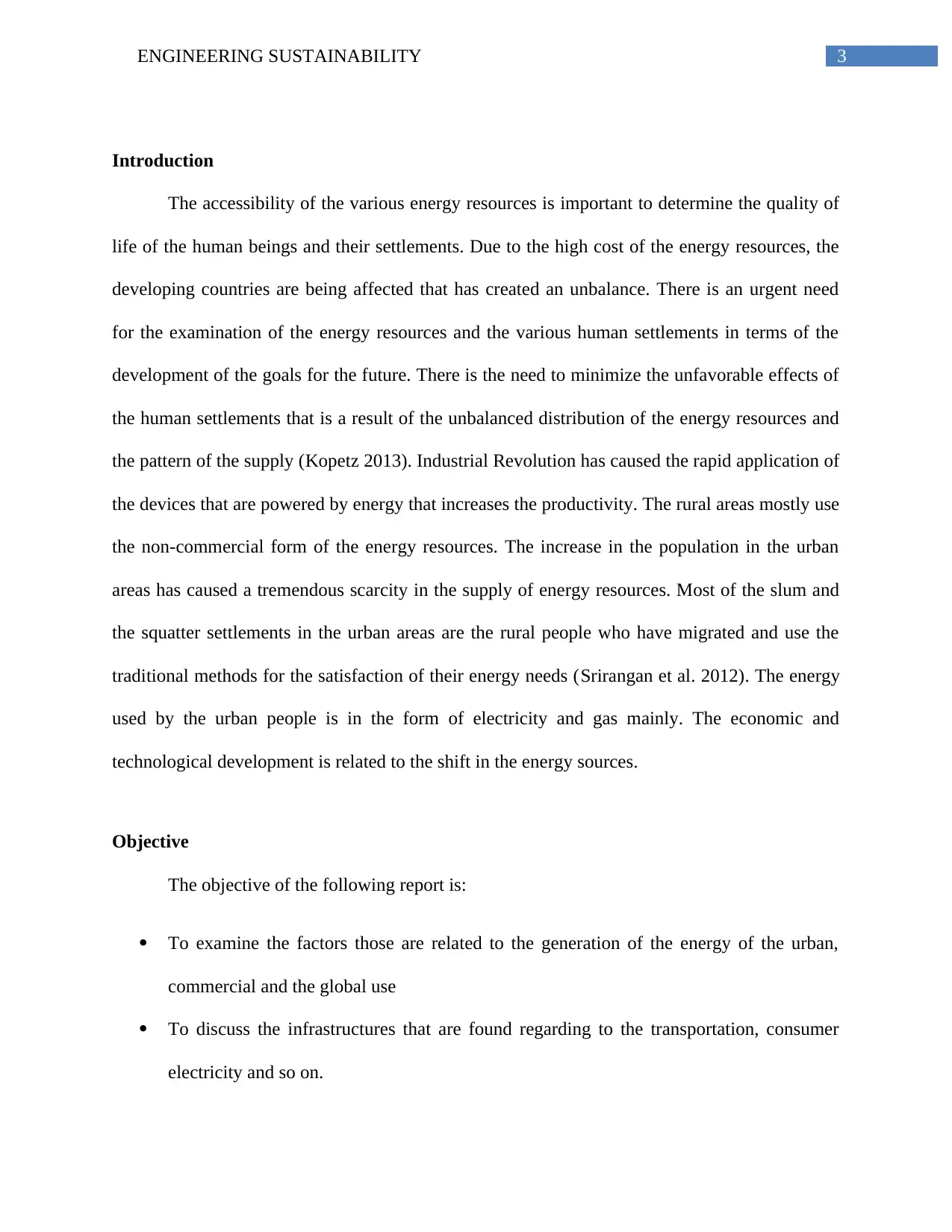
3ENGINEERING SUSTAINABILITY
Introduction
The accessibility of the various energy resources is important to determine the quality of
life of the human beings and their settlements. Due to the high cost of the energy resources, the
developing countries are being affected that has created an unbalance. There is an urgent need
for the examination of the energy resources and the various human settlements in terms of the
development of the goals for the future. There is the need to minimize the unfavorable effects of
the human settlements that is a result of the unbalanced distribution of the energy resources and
the pattern of the supply (Kopetz 2013). Industrial Revolution has caused the rapid application of
the devices that are powered by energy that increases the productivity. The rural areas mostly use
the non-commercial form of the energy resources. The increase in the population in the urban
areas has caused a tremendous scarcity in the supply of energy resources. Most of the slum and
the squatter settlements in the urban areas are the rural people who have migrated and use the
traditional methods for the satisfaction of their energy needs (Srirangan et al. 2012). The energy
used by the urban people is in the form of electricity and gas mainly. The economic and
technological development is related to the shift in the energy sources.
Objective
The objective of the following report is:
To examine the factors those are related to the generation of the energy of the urban,
commercial and the global use
To discuss the infrastructures that are found regarding to the transportation, consumer
electricity and so on.
Introduction
The accessibility of the various energy resources is important to determine the quality of
life of the human beings and their settlements. Due to the high cost of the energy resources, the
developing countries are being affected that has created an unbalance. There is an urgent need
for the examination of the energy resources and the various human settlements in terms of the
development of the goals for the future. There is the need to minimize the unfavorable effects of
the human settlements that is a result of the unbalanced distribution of the energy resources and
the pattern of the supply (Kopetz 2013). Industrial Revolution has caused the rapid application of
the devices that are powered by energy that increases the productivity. The rural areas mostly use
the non-commercial form of the energy resources. The increase in the population in the urban
areas has caused a tremendous scarcity in the supply of energy resources. Most of the slum and
the squatter settlements in the urban areas are the rural people who have migrated and use the
traditional methods for the satisfaction of their energy needs (Srirangan et al. 2012). The energy
used by the urban people is in the form of electricity and gas mainly. The economic and
technological development is related to the shift in the energy sources.
Objective
The objective of the following report is:
To examine the factors those are related to the generation of the energy of the urban,
commercial and the global use
To discuss the infrastructures that are found regarding to the transportation, consumer
electricity and so on.
Paraphrase This Document
Need a fresh take? Get an instant paraphrase of this document with our AI Paraphraser
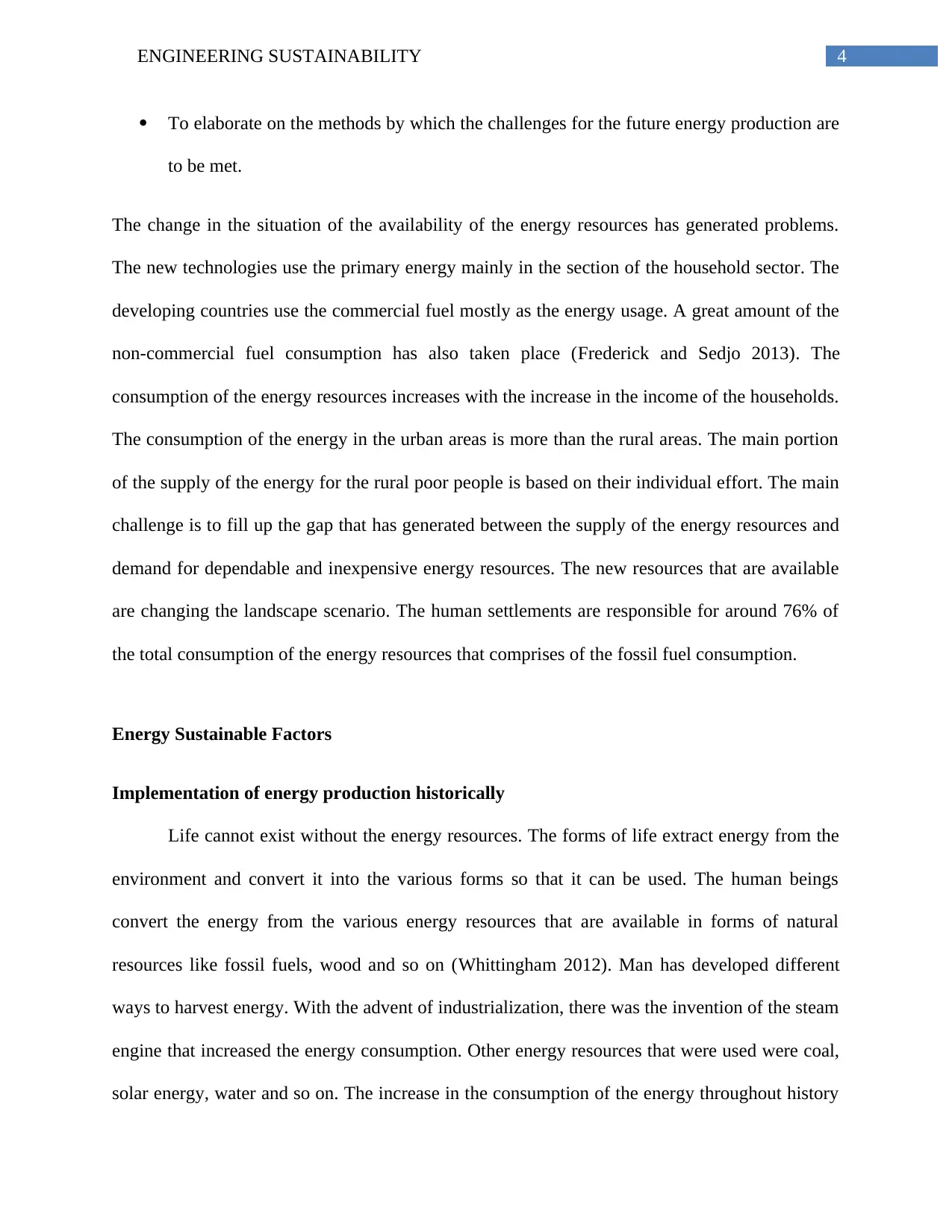
4ENGINEERING SUSTAINABILITY
To elaborate on the methods by which the challenges for the future energy production are
to be met.
The change in the situation of the availability of the energy resources has generated problems.
The new technologies use the primary energy mainly in the section of the household sector. The
developing countries use the commercial fuel mostly as the energy usage. A great amount of the
non-commercial fuel consumption has also taken place (Frederick and Sedjo 2013). The
consumption of the energy resources increases with the increase in the income of the households.
The consumption of the energy in the urban areas is more than the rural areas. The main portion
of the supply of the energy for the rural poor people is based on their individual effort. The main
challenge is to fill up the gap that has generated between the supply of the energy resources and
demand for dependable and inexpensive energy resources. The new resources that are available
are changing the landscape scenario. The human settlements are responsible for around 76% of
the total consumption of the energy resources that comprises of the fossil fuel consumption.
Energy Sustainable Factors
Implementation of energy production historically
Life cannot exist without the energy resources. The forms of life extract energy from the
environment and convert it into the various forms so that it can be used. The human beings
convert the energy from the various energy resources that are available in forms of natural
resources like fossil fuels, wood and so on (Whittingham 2012). Man has developed different
ways to harvest energy. With the advent of industrialization, there was the invention of the steam
engine that increased the energy consumption. Other energy resources that were used were coal,
solar energy, water and so on. The increase in the consumption of the energy throughout history
To elaborate on the methods by which the challenges for the future energy production are
to be met.
The change in the situation of the availability of the energy resources has generated problems.
The new technologies use the primary energy mainly in the section of the household sector. The
developing countries use the commercial fuel mostly as the energy usage. A great amount of the
non-commercial fuel consumption has also taken place (Frederick and Sedjo 2013). The
consumption of the energy resources increases with the increase in the income of the households.
The consumption of the energy in the urban areas is more than the rural areas. The main portion
of the supply of the energy for the rural poor people is based on their individual effort. The main
challenge is to fill up the gap that has generated between the supply of the energy resources and
demand for dependable and inexpensive energy resources. The new resources that are available
are changing the landscape scenario. The human settlements are responsible for around 76% of
the total consumption of the energy resources that comprises of the fossil fuel consumption.
Energy Sustainable Factors
Implementation of energy production historically
Life cannot exist without the energy resources. The forms of life extract energy from the
environment and convert it into the various forms so that it can be used. The human beings
convert the energy from the various energy resources that are available in forms of natural
resources like fossil fuels, wood and so on (Whittingham 2012). Man has developed different
ways to harvest energy. With the advent of industrialization, there was the invention of the steam
engine that increased the energy consumption. Other energy resources that were used were coal,
solar energy, water and so on. The increase in the consumption of the energy throughout history
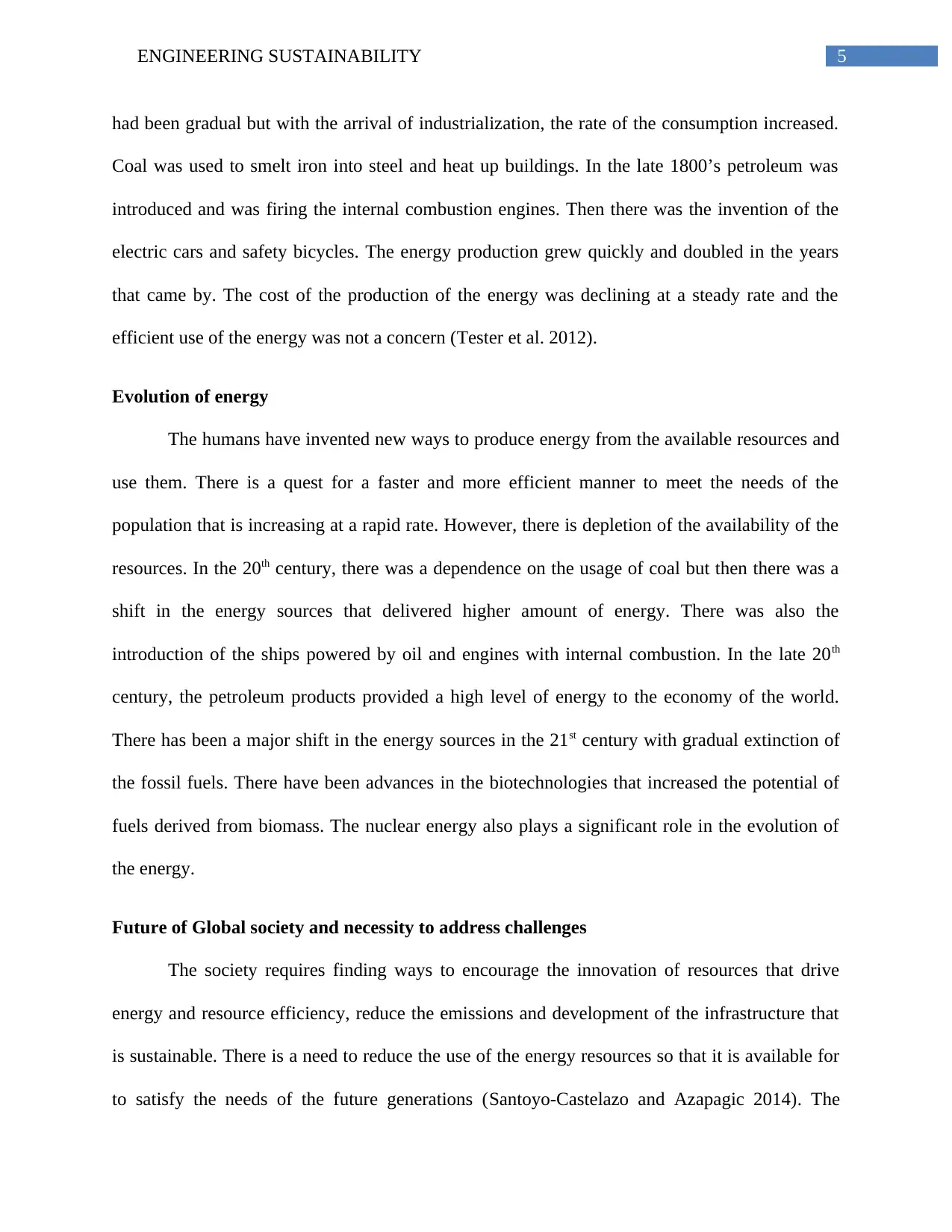
5ENGINEERING SUSTAINABILITY
had been gradual but with the arrival of industrialization, the rate of the consumption increased.
Coal was used to smelt iron into steel and heat up buildings. In the late 1800’s petroleum was
introduced and was firing the internal combustion engines. Then there was the invention of the
electric cars and safety bicycles. The energy production grew quickly and doubled in the years
that came by. The cost of the production of the energy was declining at a steady rate and the
efficient use of the energy was not a concern (Tester et al. 2012).
Evolution of energy
The humans have invented new ways to produce energy from the available resources and
use them. There is a quest for a faster and more efficient manner to meet the needs of the
population that is increasing at a rapid rate. However, there is depletion of the availability of the
resources. In the 20th century, there was a dependence on the usage of coal but then there was a
shift in the energy sources that delivered higher amount of energy. There was also the
introduction of the ships powered by oil and engines with internal combustion. In the late 20th
century, the petroleum products provided a high level of energy to the economy of the world.
There has been a major shift in the energy sources in the 21st century with gradual extinction of
the fossil fuels. There have been advances in the biotechnologies that increased the potential of
fuels derived from biomass. The nuclear energy also plays a significant role in the evolution of
the energy.
Future of Global society and necessity to address challenges
The society requires finding ways to encourage the innovation of resources that drive
energy and resource efficiency, reduce the emissions and development of the infrastructure that
is sustainable. There is a need to reduce the use of the energy resources so that it is available for
to satisfy the needs of the future generations (Santoyo-Castelazo and Azapagic 2014). The
had been gradual but with the arrival of industrialization, the rate of the consumption increased.
Coal was used to smelt iron into steel and heat up buildings. In the late 1800’s petroleum was
introduced and was firing the internal combustion engines. Then there was the invention of the
electric cars and safety bicycles. The energy production grew quickly and doubled in the years
that came by. The cost of the production of the energy was declining at a steady rate and the
efficient use of the energy was not a concern (Tester et al. 2012).
Evolution of energy
The humans have invented new ways to produce energy from the available resources and
use them. There is a quest for a faster and more efficient manner to meet the needs of the
population that is increasing at a rapid rate. However, there is depletion of the availability of the
resources. In the 20th century, there was a dependence on the usage of coal but then there was a
shift in the energy sources that delivered higher amount of energy. There was also the
introduction of the ships powered by oil and engines with internal combustion. In the late 20th
century, the petroleum products provided a high level of energy to the economy of the world.
There has been a major shift in the energy sources in the 21st century with gradual extinction of
the fossil fuels. There have been advances in the biotechnologies that increased the potential of
fuels derived from biomass. The nuclear energy also plays a significant role in the evolution of
the energy.
Future of Global society and necessity to address challenges
The society requires finding ways to encourage the innovation of resources that drive
energy and resource efficiency, reduce the emissions and development of the infrastructure that
is sustainable. There is a need to reduce the use of the energy resources so that it is available for
to satisfy the needs of the future generations (Santoyo-Castelazo and Azapagic 2014). The
⊘ This is a preview!⊘
Do you want full access?
Subscribe today to unlock all pages.

Trusted by 1+ million students worldwide
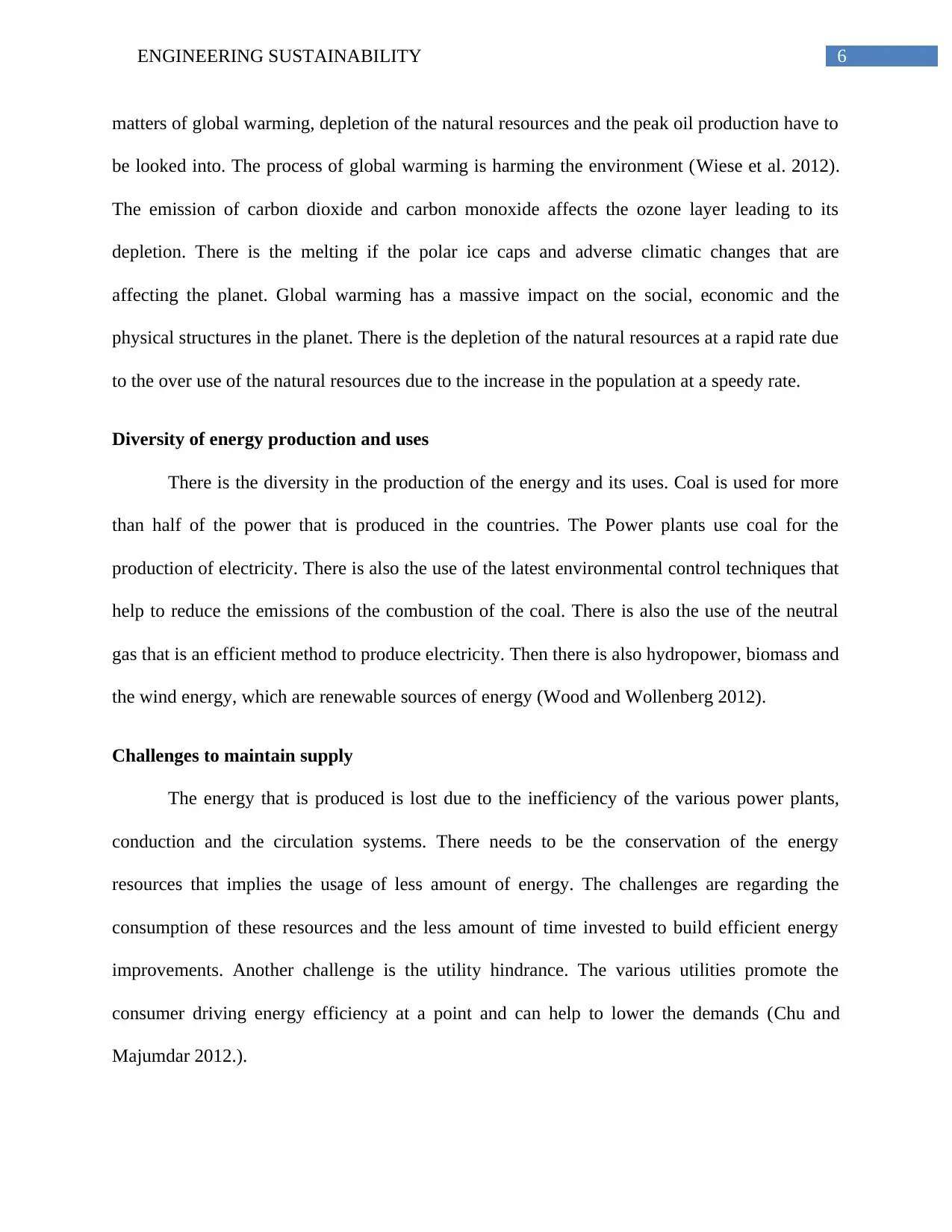
6ENGINEERING SUSTAINABILITY
matters of global warming, depletion of the natural resources and the peak oil production have to
be looked into. The process of global warming is harming the environment (Wiese et al. 2012).
The emission of carbon dioxide and carbon monoxide affects the ozone layer leading to its
depletion. There is the melting if the polar ice caps and adverse climatic changes that are
affecting the planet. Global warming has a massive impact on the social, economic and the
physical structures in the planet. There is the depletion of the natural resources at a rapid rate due
to the over use of the natural resources due to the increase in the population at a speedy rate.
Diversity of energy production and uses
There is the diversity in the production of the energy and its uses. Coal is used for more
than half of the power that is produced in the countries. The Power plants use coal for the
production of electricity. There is also the use of the latest environmental control techniques that
help to reduce the emissions of the combustion of the coal. There is also the use of the neutral
gas that is an efficient method to produce electricity. Then there is also hydropower, biomass and
the wind energy, which are renewable sources of energy (Wood and Wollenberg 2012).
Challenges to maintain supply
The energy that is produced is lost due to the inefficiency of the various power plants,
conduction and the circulation systems. There needs to be the conservation of the energy
resources that implies the usage of less amount of energy. The challenges are regarding the
consumption of these resources and the less amount of time invested to build efficient energy
improvements. Another challenge is the utility hindrance. The various utilities promote the
consumer driving energy efficiency at a point and can help to lower the demands (Chu and
Majumdar 2012.).
matters of global warming, depletion of the natural resources and the peak oil production have to
be looked into. The process of global warming is harming the environment (Wiese et al. 2012).
The emission of carbon dioxide and carbon monoxide affects the ozone layer leading to its
depletion. There is the melting if the polar ice caps and adverse climatic changes that are
affecting the planet. Global warming has a massive impact on the social, economic and the
physical structures in the planet. There is the depletion of the natural resources at a rapid rate due
to the over use of the natural resources due to the increase in the population at a speedy rate.
Diversity of energy production and uses
There is the diversity in the production of the energy and its uses. Coal is used for more
than half of the power that is produced in the countries. The Power plants use coal for the
production of electricity. There is also the use of the latest environmental control techniques that
help to reduce the emissions of the combustion of the coal. There is also the use of the neutral
gas that is an efficient method to produce electricity. Then there is also hydropower, biomass and
the wind energy, which are renewable sources of energy (Wood and Wollenberg 2012).
Challenges to maintain supply
The energy that is produced is lost due to the inefficiency of the various power plants,
conduction and the circulation systems. There needs to be the conservation of the energy
resources that implies the usage of less amount of energy. The challenges are regarding the
consumption of these resources and the less amount of time invested to build efficient energy
improvements. Another challenge is the utility hindrance. The various utilities promote the
consumer driving energy efficiency at a point and can help to lower the demands (Chu and
Majumdar 2012.).
Paraphrase This Document
Need a fresh take? Get an instant paraphrase of this document with our AI Paraphraser
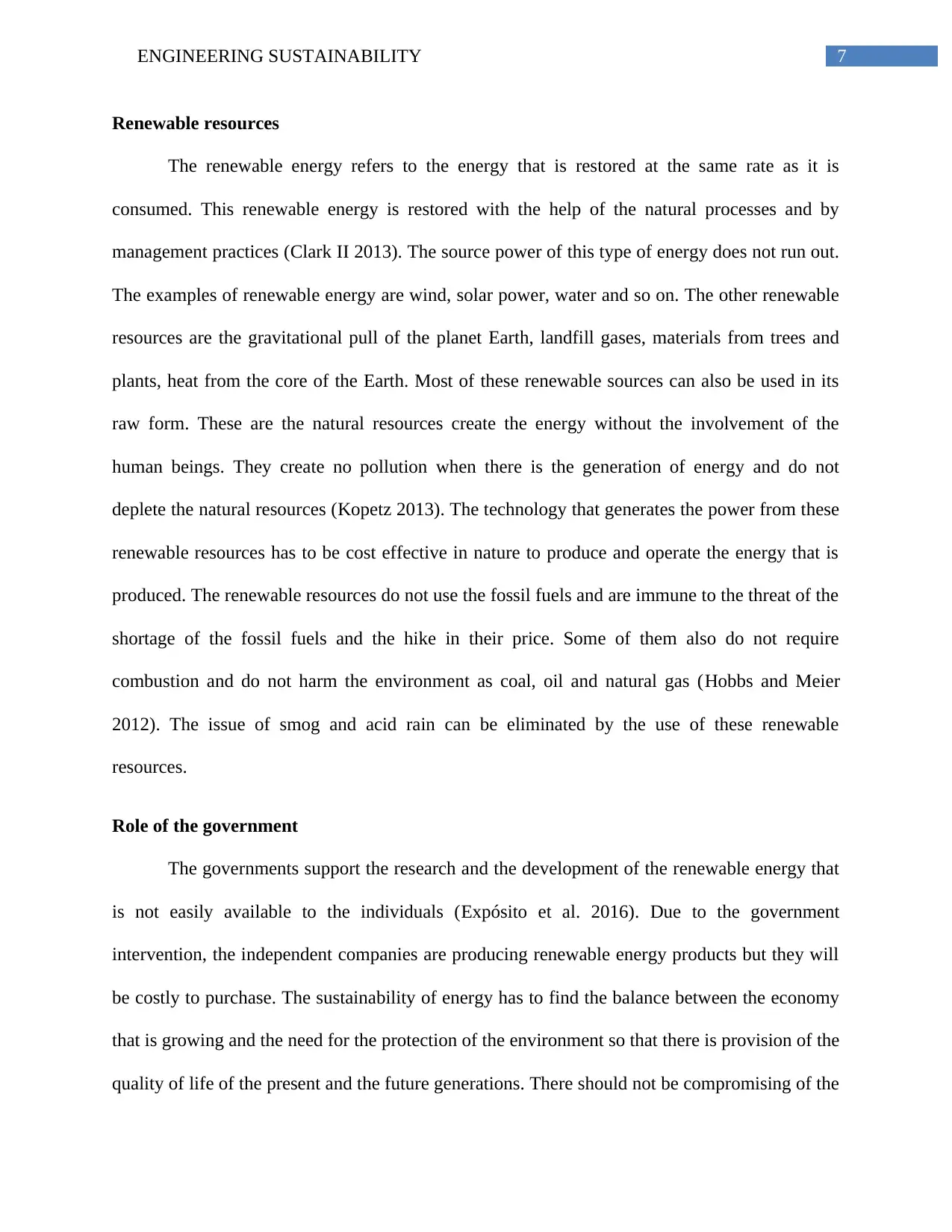
7ENGINEERING SUSTAINABILITY
Renewable resources
The renewable energy refers to the energy that is restored at the same rate as it is
consumed. This renewable energy is restored with the help of the natural processes and by
management practices (Clark II 2013). The source power of this type of energy does not run out.
The examples of renewable energy are wind, solar power, water and so on. The other renewable
resources are the gravitational pull of the planet Earth, landfill gases, materials from trees and
plants, heat from the core of the Earth. Most of these renewable sources can also be used in its
raw form. These are the natural resources create the energy without the involvement of the
human beings. They create no pollution when there is the generation of energy and do not
deplete the natural resources (Kopetz 2013). The technology that generates the power from these
renewable resources has to be cost effective in nature to produce and operate the energy that is
produced. The renewable resources do not use the fossil fuels and are immune to the threat of the
shortage of the fossil fuels and the hike in their price. Some of them also do not require
combustion and do not harm the environment as coal, oil and natural gas (Hobbs and Meier
2012). The issue of smog and acid rain can be eliminated by the use of these renewable
resources.
Role of the government
The governments support the research and the development of the renewable energy that
is not easily available to the individuals (Expósito et al. 2016). Due to the government
intervention, the independent companies are producing renewable energy products but they will
be costly to purchase. The sustainability of energy has to find the balance between the economy
that is growing and the need for the protection of the environment so that there is provision of the
quality of life of the present and the future generations. There should not be compromising of the
Renewable resources
The renewable energy refers to the energy that is restored at the same rate as it is
consumed. This renewable energy is restored with the help of the natural processes and by
management practices (Clark II 2013). The source power of this type of energy does not run out.
The examples of renewable energy are wind, solar power, water and so on. The other renewable
resources are the gravitational pull of the planet Earth, landfill gases, materials from trees and
plants, heat from the core of the Earth. Most of these renewable sources can also be used in its
raw form. These are the natural resources create the energy without the involvement of the
human beings. They create no pollution when there is the generation of energy and do not
deplete the natural resources (Kopetz 2013). The technology that generates the power from these
renewable resources has to be cost effective in nature to produce and operate the energy that is
produced. The renewable resources do not use the fossil fuels and are immune to the threat of the
shortage of the fossil fuels and the hike in their price. Some of them also do not require
combustion and do not harm the environment as coal, oil and natural gas (Hobbs and Meier
2012). The issue of smog and acid rain can be eliminated by the use of these renewable
resources.
Role of the government
The governments support the research and the development of the renewable energy that
is not easily available to the individuals (Expósito et al. 2016). Due to the government
intervention, the independent companies are producing renewable energy products but they will
be costly to purchase. The sustainability of energy has to find the balance between the economy
that is growing and the need for the protection of the environment so that there is provision of the
quality of life of the present and the future generations. There should not be compromising of the
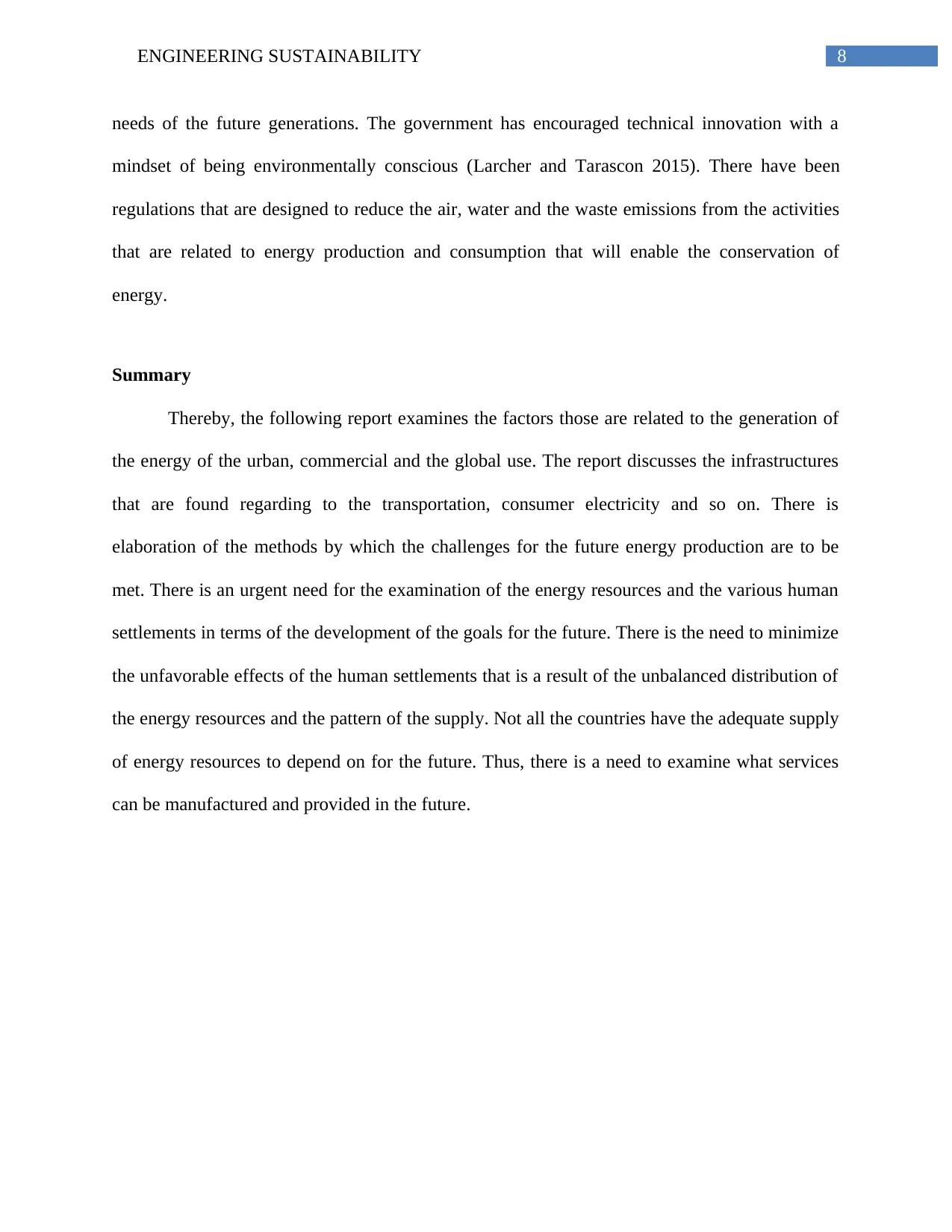
8ENGINEERING SUSTAINABILITY
needs of the future generations. The government has encouraged technical innovation with a
mindset of being environmentally conscious (Larcher and Tarascon 2015). There have been
regulations that are designed to reduce the air, water and the waste emissions from the activities
that are related to energy production and consumption that will enable the conservation of
energy.
Summary
Thereby, the following report examines the factors those are related to the generation of
the energy of the urban, commercial and the global use. The report discusses the infrastructures
that are found regarding to the transportation, consumer electricity and so on. There is
elaboration of the methods by which the challenges for the future energy production are to be
met. There is an urgent need for the examination of the energy resources and the various human
settlements in terms of the development of the goals for the future. There is the need to minimize
the unfavorable effects of the human settlements that is a result of the unbalanced distribution of
the energy resources and the pattern of the supply. Not all the countries have the adequate supply
of energy resources to depend on for the future. Thus, there is a need to examine what services
can be manufactured and provided in the future.
needs of the future generations. The government has encouraged technical innovation with a
mindset of being environmentally conscious (Larcher and Tarascon 2015). There have been
regulations that are designed to reduce the air, water and the waste emissions from the activities
that are related to energy production and consumption that will enable the conservation of
energy.
Summary
Thereby, the following report examines the factors those are related to the generation of
the energy of the urban, commercial and the global use. The report discusses the infrastructures
that are found regarding to the transportation, consumer electricity and so on. There is
elaboration of the methods by which the challenges for the future energy production are to be
met. There is an urgent need for the examination of the energy resources and the various human
settlements in terms of the development of the goals for the future. There is the need to minimize
the unfavorable effects of the human settlements that is a result of the unbalanced distribution of
the energy resources and the pattern of the supply. Not all the countries have the adequate supply
of energy resources to depend on for the future. Thus, there is a need to examine what services
can be manufactured and provided in the future.
⊘ This is a preview!⊘
Do you want full access?
Subscribe today to unlock all pages.

Trusted by 1+ million students worldwide
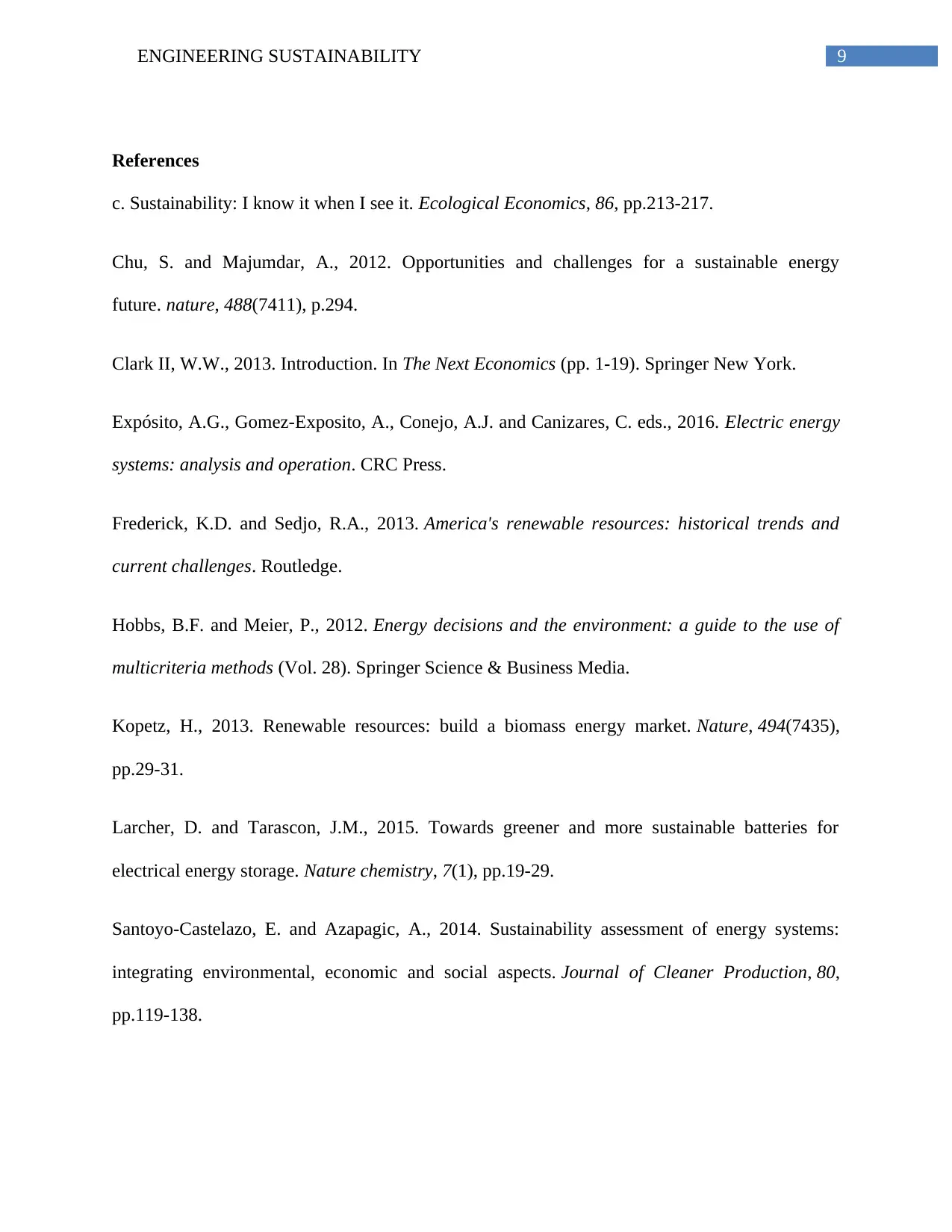
9ENGINEERING SUSTAINABILITY
References
c. Sustainability: I know it when I see it. Ecological Economics, 86, pp.213-217.
Chu, S. and Majumdar, A., 2012. Opportunities and challenges for a sustainable energy
future. nature, 488(7411), p.294.
Clark II, W.W., 2013. Introduction. In The Next Economics (pp. 1-19). Springer New York.
Expósito, A.G., Gomez-Exposito, A., Conejo, A.J. and Canizares, C. eds., 2016. Electric energy
systems: analysis and operation. CRC Press.
Frederick, K.D. and Sedjo, R.A., 2013. America's renewable resources: historical trends and
current challenges. Routledge.
Hobbs, B.F. and Meier, P., 2012. Energy decisions and the environment: a guide to the use of
multicriteria methods (Vol. 28). Springer Science & Business Media.
Kopetz, H., 2013. Renewable resources: build a biomass energy market. Nature, 494(7435),
pp.29-31.
Larcher, D. and Tarascon, J.M., 2015. Towards greener and more sustainable batteries for
electrical energy storage. Nature chemistry, 7(1), pp.19-29.
Santoyo-Castelazo, E. and Azapagic, A., 2014. Sustainability assessment of energy systems:
integrating environmental, economic and social aspects. Journal of Cleaner Production, 80,
pp.119-138.
References
c. Sustainability: I know it when I see it. Ecological Economics, 86, pp.213-217.
Chu, S. and Majumdar, A., 2012. Opportunities and challenges for a sustainable energy
future. nature, 488(7411), p.294.
Clark II, W.W., 2013. Introduction. In The Next Economics (pp. 1-19). Springer New York.
Expósito, A.G., Gomez-Exposito, A., Conejo, A.J. and Canizares, C. eds., 2016. Electric energy
systems: analysis and operation. CRC Press.
Frederick, K.D. and Sedjo, R.A., 2013. America's renewable resources: historical trends and
current challenges. Routledge.
Hobbs, B.F. and Meier, P., 2012. Energy decisions and the environment: a guide to the use of
multicriteria methods (Vol. 28). Springer Science & Business Media.
Kopetz, H., 2013. Renewable resources: build a biomass energy market. Nature, 494(7435),
pp.29-31.
Larcher, D. and Tarascon, J.M., 2015. Towards greener and more sustainable batteries for
electrical energy storage. Nature chemistry, 7(1), pp.19-29.
Santoyo-Castelazo, E. and Azapagic, A., 2014. Sustainability assessment of energy systems:
integrating environmental, economic and social aspects. Journal of Cleaner Production, 80,
pp.119-138.
Paraphrase This Document
Need a fresh take? Get an instant paraphrase of this document with our AI Paraphraser
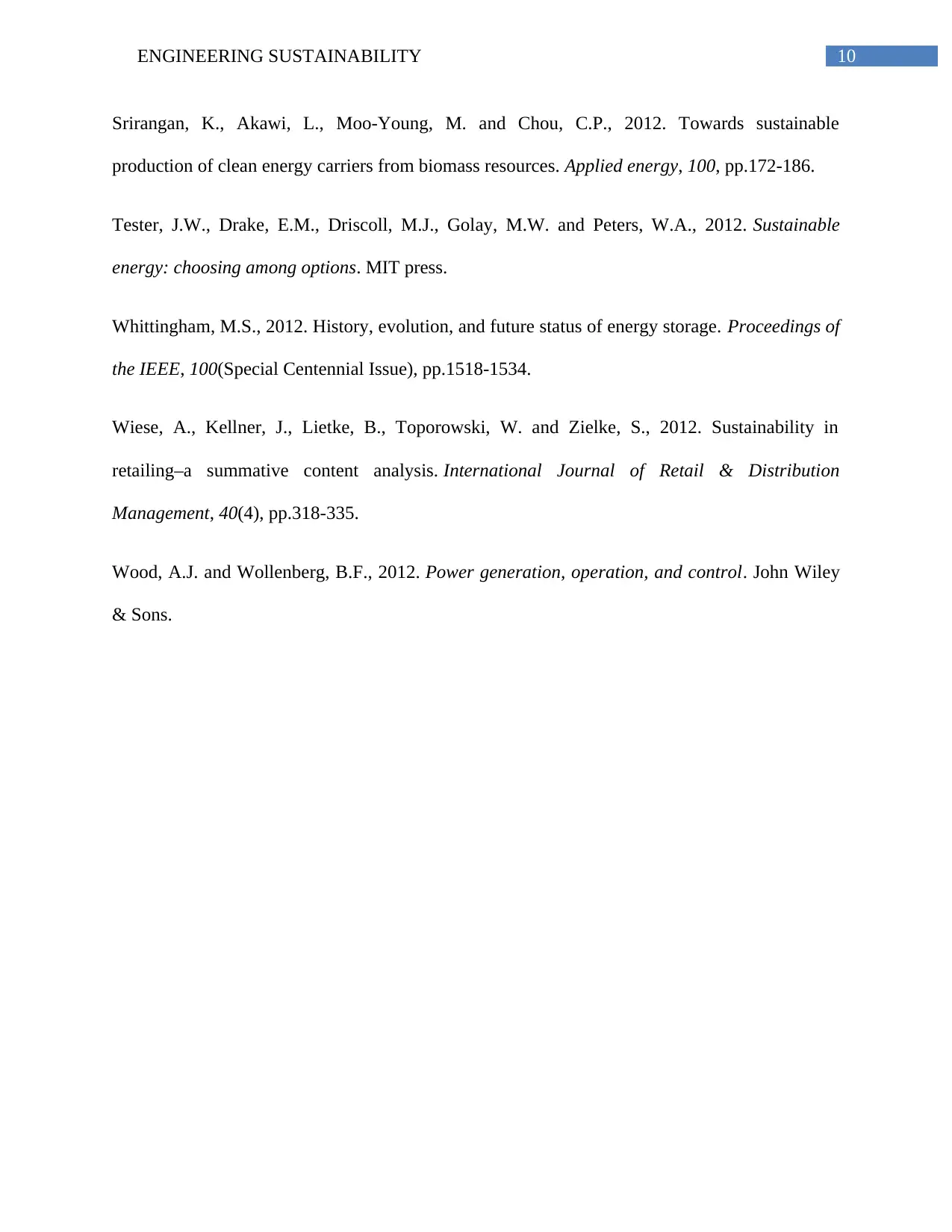
10ENGINEERING SUSTAINABILITY
Srirangan, K., Akawi, L., Moo-Young, M. and Chou, C.P., 2012. Towards sustainable
production of clean energy carriers from biomass resources. Applied energy, 100, pp.172-186.
Tester, J.W., Drake, E.M., Driscoll, M.J., Golay, M.W. and Peters, W.A., 2012. Sustainable
energy: choosing among options. MIT press.
Whittingham, M.S., 2012. History, evolution, and future status of energy storage. Proceedings of
the IEEE, 100(Special Centennial Issue), pp.1518-1534.
Wiese, A., Kellner, J., Lietke, B., Toporowski, W. and Zielke, S., 2012. Sustainability in
retailing–a summative content analysis. International Journal of Retail & Distribution
Management, 40(4), pp.318-335.
Wood, A.J. and Wollenberg, B.F., 2012. Power generation, operation, and control. John Wiley
& Sons.
Srirangan, K., Akawi, L., Moo-Young, M. and Chou, C.P., 2012. Towards sustainable
production of clean energy carriers from biomass resources. Applied energy, 100, pp.172-186.
Tester, J.W., Drake, E.M., Driscoll, M.J., Golay, M.W. and Peters, W.A., 2012. Sustainable
energy: choosing among options. MIT press.
Whittingham, M.S., 2012. History, evolution, and future status of energy storage. Proceedings of
the IEEE, 100(Special Centennial Issue), pp.1518-1534.
Wiese, A., Kellner, J., Lietke, B., Toporowski, W. and Zielke, S., 2012. Sustainability in
retailing–a summative content analysis. International Journal of Retail & Distribution
Management, 40(4), pp.318-335.
Wood, A.J. and Wollenberg, B.F., 2012. Power generation, operation, and control. John Wiley
& Sons.
1 out of 11
Related Documents
Your All-in-One AI-Powered Toolkit for Academic Success.
+13062052269
info@desklib.com
Available 24*7 on WhatsApp / Email
![[object Object]](/_next/static/media/star-bottom.7253800d.svg)
Unlock your academic potential
Copyright © 2020–2025 A2Z Services. All Rights Reserved. Developed and managed by ZUCOL.





